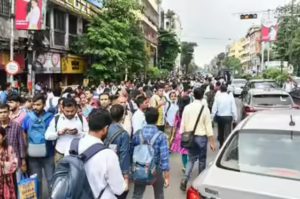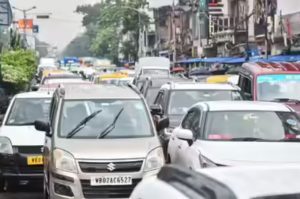Kolkata Metro — A combination of tunnel water seepage and a tragic suicide brought Kolkata’s Metro services to a standstill during peak hours on Monday, causing severe hardship for thousands of commuters. The day was marred by delays, cancellations, traffic chaos, and rising public frustration.

Flooding Forces Temporary Suspension of Services
Trouble began early in the morning when water seepage was detected inside the tunnel between Chandni Chowk and Central metro stations. Metro authorities were alerted by patrol personnel and immediately cut off power to the third rail to avoid any electrical hazards. This resulted in the suspension of services between Maidan and Girish Park stations from 9:05 AM to 10:58 AM.
As a precaution, water was pumped out, leakage points were sealed, and services were only resumed after safety checks were conducted. However, the interruption led to a cascading effect across the Blue Line. Several trains were delayed or rescheduled, and announcements were made at all major stations to inform passengers.


Later in the day, around 3:35 PM, a similar issue emerged between Jatin Das Park and Netaji Bhavan, prompting another service halt. Though resolved within an hour, these repeated breakdowns disrupted the entire day’s Metro schedule.
Tragedy at Belgachhia Station
In a heart-wrenching development, a 69-year-old man allegedly died by suicide at Belgachhia Metro station. The incident occurred around 11:20 AM, further compounding the commuter crisis. The individual jumped in front of an approaching New Garia-bound train and was declared dead after being rushed to RG Kar Medical College and Hospital.
As authorities managed the situation, services between Girish Park and Noapara were suspended again, resuming only by 12:28 PM. This created an unprecedented three-part disruption on the same day, with major operational gaps at critical hours.
Kolkata Metro: City Comes to a Standstill
With Metro services suspended intermittently throughout the day, roads across the city were choked with traffic. Central Avenue, MG Road, BB Ganguly Street, and Bidhan Sarani witnessed severe waterlogging, slowing vehicular movement. Auto-rickshaws and buses were overcrowded, and app-based taxis saw an immediate surge in demand and pricing.
Many commuters resorted to walking long distances to reach their workplaces or return home. For office-goers and students alike, the day turned into a logistical nightmare.
Drainage System Under Scrutiny
The Metro Railway authority attributed the water seepage to heavy rainfall and surface water entering the tunnel system. While they claimed prompt action in sealing the leakage points, questions arose about the long-term viability of drainage systems along Metro corridors.
Kolkata Municipal Corporation (KMC) drainage department chief Tarak Singh, however, rejected the suggestion that KMC’s inefficiency was to blame. He pointed out that Metro tunnels were designed and maintained independently and called for greater coordination between Metro engineers and city drainage teams.
The finger-pointing between agencies did little to reassure frustrated commuters who endured long waits and poor communication.
Recurring Problems Raise Red Flags
This was not the first time Kolkata Metro services were impacted by water seepage. In May 2024, after Cyclone Remal, similar flooding was reported between Esplanade and Park Street stations. Despite several assurances and technical upgrades, the problem has resurfaced—raising concerns about the effectiveness of existing tunnel infrastructure in handling monsoon-related stress.
Moreover, in recent months, Metro services have faced repeated disruptions due to track faults, signal failures, and now water ingress. Each breakdown chips away at public confidence in what was once Kolkata’s most reliable mode of transport.
Metro Authorities Respond
In an official statement, Metro Railway expressed regret over the disruptions and stated:
“Services had to be temporarily suspended for the safety of passengers and staff. Our engineers immediately responded to water leakage alerts and resumed operations as soon as it was deemed safe.”
They also mentioned that new pumping mechanisms and advanced sealing techniques are being reviewed for implementation across vulnerable tunnel zones.
As for the suicide incident, Metro officials cooperated with local police and security to ensure swift medical and legal response. They again appealed to passengers to seek help if facing mental distress, and reiterated that emergency helpline numbers are displayed prominently across stations.
Call for Safety Infrastructure
The suicide incident reignited discussions on the need for platform screen doors (PSDs)—a safety feature currently available only on select Metro corridors like the East-West line. Many citizens on social media demanded the same for the older Blue Line, which has witnessed several suicide attempts in recent years.
Passenger advocacy groups have urged authorities to speed up the installation of safety barriers and improve surveillance inside stations to prevent such tragedies.
Next Steps and Public Expectations
After a day of repeated shutdowns, Metro authorities announced that a technical audit would be conducted across all sections prone to water seepage. Engineers and external consultants are likely to be called in to inspect the condition of tunnels and suggest structural reinforcements.
Meanwhile, city residents are calling for better inter-agency coordination between the Metro Railway and the KMC, especially during monsoon months.
There is also growing pressure to establish an emergency response mechanism for passengers affected during such breakdowns—including deployment of shuttle services and better real-time communication.
Related External Links:
- Metro disruption due to water seepage and suicide – Times of India
- Kolkata Metro official site for updates
- Kolkata Municipal Corporation
- National Suicide Prevention Helpline India
Kolkata’s dependence on its Metro system has grown exponentially in recent years. As climate unpredictability and urban density rise, so must the infrastructure’s resilience. Monday’s events have not only exposed cracks in the city’s subterranean lifeline but also the urgent need for more proactive, transparent, and people-centric transit governance.
Also read: Home | Channel 6 Network – Latest News, Breaking Updates: Politics, Business, Tech & More

